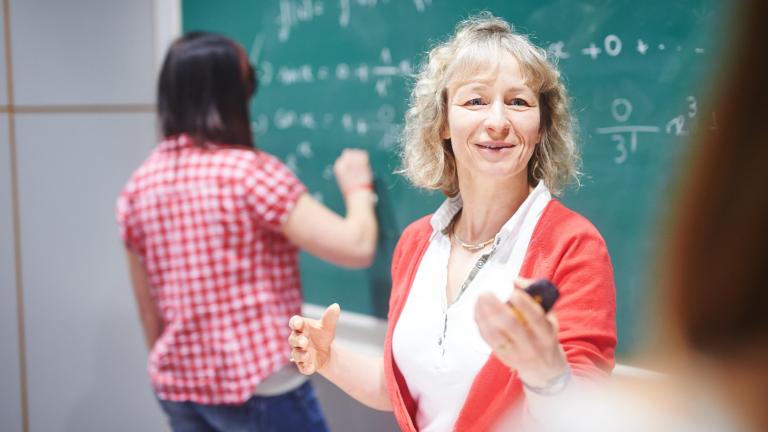Mathematics is an indispensable tool for understanding and solving many of the problems of everyday life, it forms the formal language for many disciplines and defines a science, with its methods and laws, to which genuine research is associated. The Mathematics Department has sought to reconcile these aspects by specializing in applied mathematics since its inception, in both teaching and research.
The Department of Mathematics is located in the Sciences-Arrupe building, occupying a wing on the third and fourth floors.
It is responsible for undergraduate, master's and doctoral courses in mathematics. It also teaches in other sections and faculties.
Spotlight
News
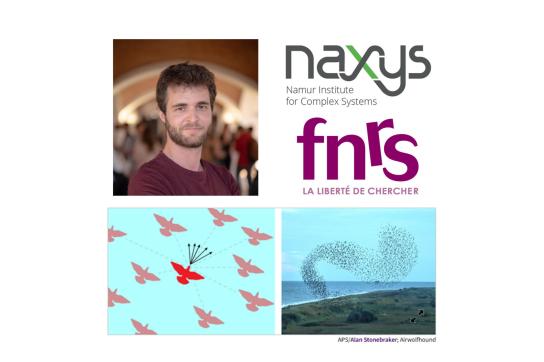
Two prestigious publications for our network dynamics researchers
Two prestigious publications for our network dynamics researchers
Maxime Lucas is an FNRS Research Fellow in the Department of Mathematics and a member of the naXys Institute. He works on complex systems within the "Network Dynamics" cluster headed by Professor Timoteo Carletti. He is co-author of two papers on complex systems, recently published in prestigious journals Nature Physics and Physical Reviews Letters.
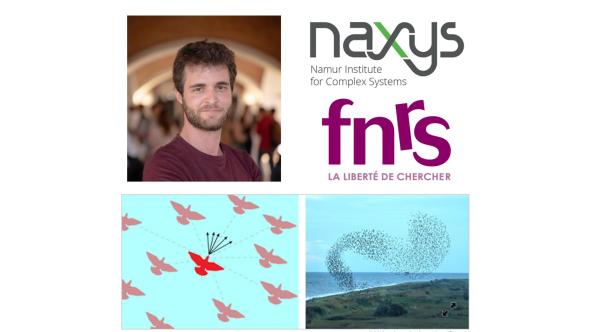
Analysis of collective behavior in complex systems
The study of complex systems published in Physical Reviews Letters supports a growing trend that focuses more on analyzing the collective behavior of a system rather than discovering the underlying mechanisms of interaction.
When we observe a flock of starlings swirling through the sky in perfect coordination - a phenomenon known as murmuration - we witness the elegant interplay of individual actions creating collective behavior. In trying to understand these fascinating patterns, researchers can isolate simple rules based on an individual bird's field of view and the distance separating it from its neighbors, but there's always the question of whether the model actually captures the processes driving interactions between birds (Fig. 1).
This is a general problem in complex systems research, which comes down to distinguishing mechanisms (the rules governing interactions) from behaviors (the observable patterns that emerge).
Figure 1: In bird flocks, each bird chooses its movement according to the separation distance and flight orientation of its neighbors (left). These simple rules can produce complex patterns, such as starling "murmurations" (right). New research explores how mechanisms (individual rules) are linked to behaviors (collective patterns) in networks that represent complex systems.
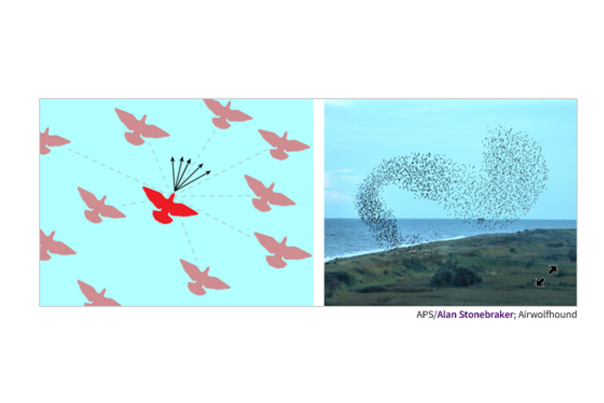
Representative networks of interacting individuals, or nodes, are a good way to study mechanisms versus behaviors. Until now, researchers have focused on pairwise interactions, but many systems also include higher-order interactions between several nodes. The impact of these higher-order mechanisms on behavior has not been clearly established. Thomas Robiglio, from the Central European University in Vienna, and his colleagues, including Maxime Lucas (CR FNRS - UNamur) addressed this question. They considered networks with higher-order interactions and evaluated the resulting behaviors in terms of statistical dependencies between node values.
The researchers identified higher-order behavioral signatures which, unlike their pairwise counterparts, reveal the presence of higher-order mechanisms. Their findings open up new avenues for distinguishing mechanisms and behaviors when studying complex systems - a distinction that is crucial for the study of inference in network science, neuroscience, the social sciences and beyond.
This study is also the subject of a "Featured in Physics" and "Editor's suggestion" article, and a "commentary" article at the journal's request, available on their website in English in full.
Namur Institute for Complex Systems (naXys)
The naXys institute specializes in the analysis of complex systems, whether in astronomy and dynamic cosmology, mathematical biology, optimization in optics, economic complexity or the study of the stability and robustness of these systems.

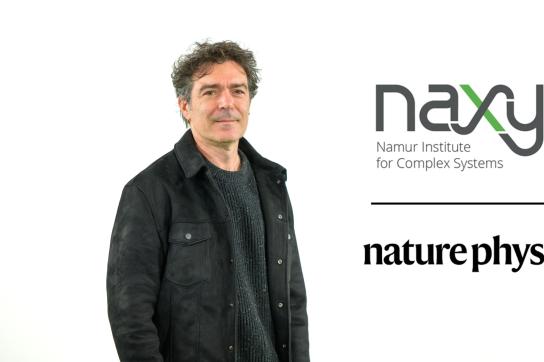
UNamur researchers published in Nature Physics
UNamur researchers published in Nature Physics
Professor Timoteo Carletti of the University of Namur has just published in the prestigious journal Nature Physics in collaboration with Professor Ginestra Bianconi of Queen Mary University of London and eight other international researchers. This groundbreaking study could lead to the development of new AI algorithms, new ways of studying brain function, or breakthroughs in disciplines such as physics, climate science, finance and many others.
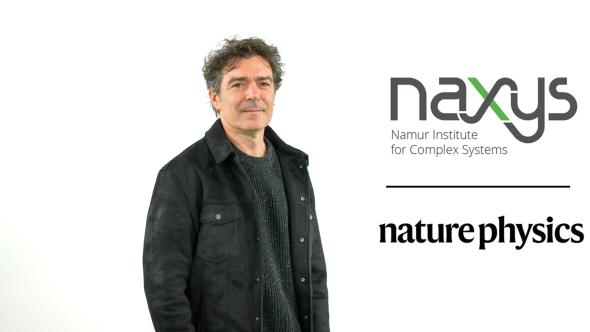
The study, entitled "Topology shapes dynamics of higher-order networks" proposes a theoretical framework specifically designed to understand complex higher-order networks where several agents interact at the same time and thus generalize networks with their interactions in pairs. More precisely, the study shows how topology shapes dynamics, how dynamics learns topology and how topology evolves dynamically.
The aim of this work is to introduce physicists, mathematicians, computer scientists and network scientists to this emerging research field, as well as to define future research challenges where discrete topology and nonlinear dynamics mix.
With the data in their possession, the researchers show that real-life complex systems such as the brain, chemical reactions and neural networks can be easily modeled as higher-order networks, characterized by multi-body connections indicating the fact that several elements of the system interact simultaneously.
This international team is convinced that the visibility of their work through this publication in Nature Physics will open the door to new collaborations with other disciplines that rely on network analysis to study real complex systems.
Kudos to the team for this publication!
Timoteo Carletti - Mini CV
After a Master's degree in physics (University of Florence, June 1995), Timoteo Carletti pursued his doctoral studies in Florence (Italy) and Paris (France) at IMCCE, finally defending his doctoral thesis in mathematics in February 2000.
He moved to Belgium in 2005, and was hired at the University of Namur as a lecturer, then as a professor (2008), and finally as a full professor (2011) in the Mathematics Department of the Faculty of Science. In 2010, he was one of the founders of the Namur Center for Complex Systems (now the Namur Institute for Complex Systems - naXys), which he headed until December 2014.
.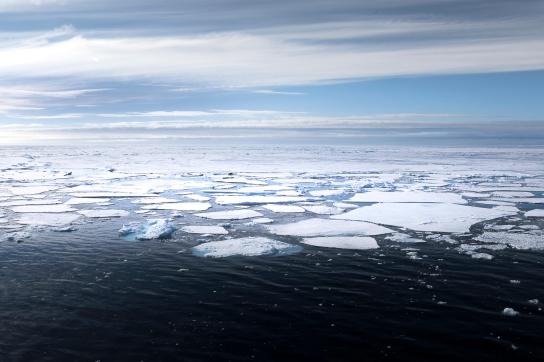
Better prediction of climate extremes
Better prediction of climate extremes
Statistics usually focus on anticipating events that fall within the norm. But what about rare events? They are dealt with by a branch of mathematics called extreme value theory, in which Anna Kiriliouk, lecturer in statistics at UNamur, is a specialist. Applied to the climate, this theory enables us to better predict extreme climatic events, at a time when these are multiplying due to climate change.
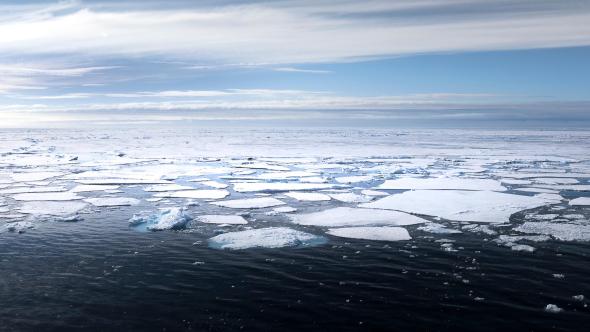
This article is taken from the "Impact" section of the December 2024 issue of Omalius magazine.
On the night of January 31, 1953, the North Sea suddenly rose by almost four meters, submerging parts of the Netherlands and Belgium. The disaster caused the death of over 2,500 people, as well as considerable damage. According to Anna Kiriliouk, lecturer in statistics at UNamur's Department of Mathematics and EMCP Faculty, this exceptional event truly marked "the beginning of the development of extreme value theory, with the development of the first extreme value construction project"
The Delta Plan, as it is called, is a system of dikes that protects the Netherlands against the risk of flooding, with these dikes overtopping once every 10,000 years. A rare danger, certainly, but not zero, which "could not have been calculated using conventional statistics, which are very poorly adapted to rare events", believes the mathematician.
While climate change is often discussed in terms of averages, such as rising temperatures and sea levels, it also has the consequence of increasing the frequency of extreme weather events, with significant repercussions for our societies. "In other words, the risk increases along with the concentration of greenhouse gases (GHGs) in the atmosphere", summarizes the researcher. "Thus, a flood calculated in 1953 to occur only every 10,000 years does not have the same significance as today. The latter could happen more frequently, for example every 1,000 years."
Attributing extreme events
While extreme weather events are on the increase, it's difficult in practice to attribute any particular flood or drought to climate change. With this in mind, Anna Kiriliouk has just been awarded an interdisciplinary research project,named EXALT, in collaboration with UCLouvain. "It involves both climatologists and statisticians, she reveals.

"This collaboration is very important, because answering this question of the attribution of extreme events can only be done through the development of a common language between our two disciplines, which currently operate separately. We have a lot to learn from each other"
In practice, the EXALT project will therefore calculate the probabilities of an extreme event occurring, and compare this probability with that of the same situation in a world where GHG emissions would not have increased. "Of course, we don't have real data from such a world", says Anna Kiriliouk. "We are therefore basing ourselves on alternative climate simulations, the quality of which we will moreover compare, with a focus on extreme events."
Divided into three working groups, the EXALT project will seek in particular to determine the role of climate change in the occurrence of floods, as well as heat waves and drought in Europe. And to do so as realistically as possible: "One of the things we want to incorporate into climate models concerns the dependency between data," explains Anna Kiriliouk. "For example, if a heat wave hits Namur, there's a good chance that the same temperatures will affect Louvain-La-Neuve. We therefore say that there is a strong spatial dependency between these two data. However, this dependence is probably not at all valid for rain, which is much more heterogeneous. By taking into account all these variables, both spatial and temporal, we hope to improve existing models."
A third working group will study much more distant areas, located in Antarctica. "Until 2016, the extent of the Antarctic ice pack was increasing, before abruptly decreasing", the researcher illuminates. "Or, according to the models, this event was considered almost impossible. But with one of EXALT's partners, we began to analyze the evolution of pack ice extent using extreme value theory. With the latter, this sudden drop was no longer so improbable. This gave us confidence in our approach, which is all the more important when the state of the pack ice has such a strong influence on other climate variables."
Compound events
This interaction between several climatic processes is, moreover, the subject of a second project just obtained by Anna Kiriliouk and funded by an FNRS Mandat d'Impulsion Scientifique. "The aim is to make it possible to study what we call compound events", explains the researcher. "During extreme climatic situations, we usually associate very high or low values simultaneously, such as a lack of rain and high temperature, resulting in an intense drought. But in the case of compound phenomena, we find that the combination of several variables, albeit in a moderate state, results in a severe and unusual event."
In 2017, for example, Hurricane Sandy, which struck the US coastline, is considered a compound event. While North Atlantic hurricanes usually dissipate in mid-ocean, this one coincided with onshore winds and a high tide, leading to massive flooding of New York and the surrounding area.
"In this project, we will therefore try to include more flexibility between the different variables, by introducing different degrees of dependence, the mathematician elaborates. "We're also going to try, as a second step, to group the dependencies together, in order to lighten the models, which become more and more complex as we add nuances to them. And once these models have been modified, we'll apply them to recent events to test their realism."
EXALT - ARC project (FWB)
Funded by the Wallonia-Brussels Federation (FWB), ARC projects are Concerted Research Action projects that aim to develop university or inter-university centers of excellence in basic research areas and, where possible, that carry out basic and applied research in an integrated way and aim to add economic and social value to research results.

Mandat d'impulsion scientifique (MIS) - FNRS
The aim of the funding granted is to support young permanent researchers wishing to develop a scientific unit within their academic institution in a promising field. This mandate has earned Anna Kiriliouk a fellowship from Namur Research College (NARC).
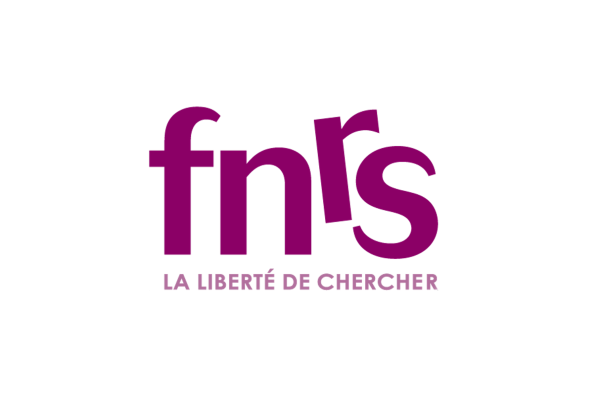
This article is taken from the "Impact" section of Omalius magazine #35 (December 2024).

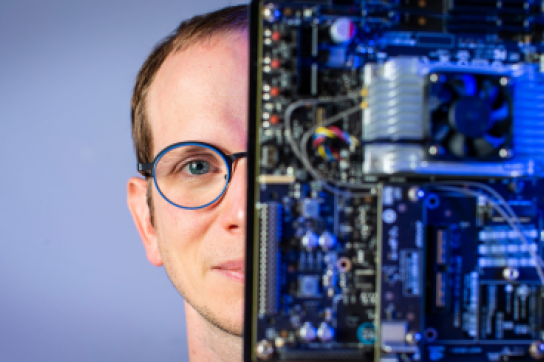
Johan Barthelemy: from the Mathematics Department to Antarctica
Johan Barthelemy: from the Mathematics Department to Antarctica
After undergraduate and graduate studies in applied mathematics at UNamur, Johan Barthelemy joined the University of Wollongong (UoW) in Australia. An expert in artificial intelligence, he now works for NVIDIA while devoting part of his time to research, mainly for the Securing Antarctica's Environmental Future (SAEF) program. A commitment that led him to participate recently in a mission to Antarctica.

Cette interview a été réalisée pour la rubrique "Alumni" du magazine Omalius #28 de mars 2023.
Pouvez-vous nous expliquer en quelques mots votre activité professionnelle actuelle ?
En tant que Developer Relations Manager auprès de NVIDIA, responsable pour l’Australie et la Nouvelle-Zélande, je suis spécialisé dans l’IA et aide les développeurs et chercheurs dans la création, l’optimisation, l’intégration et le déploiement de leurs modèles d’intelligence artificielle. Je gère également le Developer Program dédié aux grands modèles de langages pour la zone Asia Pacific South. Je dédie aussi 30 % de mon temps à la recherche, principalement pour SAEF. J’y dirige un projet qui a pour but de développer une nouvelle plateforme intelligente de capteurs pour l’Antarctique afin d’étudier le changement climatique et son impact sur la végétation locale.Je suis également Honorary Senior Research Fellow au sein de l’Université de Wollongong (UoW) où je supervise des doctorants et gère l’équipement de calcul haute performance pour l’IA.
Vous revenez d’une mission en Antarctique, quel était l’objectif de cette mission ? Et quel rôle y avez-vous joué ?
Cette expédition SAEF visait à installer une nouvelle plateforme AIoT (Artificial Intelligence of Things) à la station de recherche Casey, à étudier la mousse présente sur différents sites et à cartographier ces mêmes sites au moyen de drones. J’ai dirigé l’équipe AIoT et j’ai soutenu celle chargée de l’analyse de la mousse. Mon objectif était de déployer le prototype de la plateforme AIoT développée à l’UoW pour étudier un parterre de mousses sur le terrain. Être sur place m’a permis de déboguer le code, tester et valider les composants pour l’Antarctique et de vérifier que l’on était capable de recevoir les données en temps réels en Australie. J’ai également configuré l’infrastructure réseau LoRaWAN. Elle est la première de ce genre en Antarctique, ce qui ouvre la porte au déploiement de capteurs permettant d’envoyer des données en temps réels vers l’Australie et placés à plusieurs dizaines de kilomètres de Casey.Au sein de l’équipe qui étudiait la mousse, j’ai participé à l’installation de capteurs, la collecte de données, et d’échantillons de différentes variétés de mousses ainsi que d’échantillons d’eau provenant de lacs dans les différents sites. Nous avons également pris une grande quantité de photos et de scans hyperspectral des sites que nous avons visités.
Quel est l’apport des mathématiques dans ce type de mission environnementale ?
Les données récoltées avec la plateforme AIoT et sur le terrain seront utilisées pour développer différents modèles de microclimat et comprendre l’évolution de la végétation en Antarctique ainsi que l’impact du réchauffement climatique. Les scans et photos seront utilisés pour créer des modèles d’intelligence artificielle. Ils permettront d’analyser automatiquement les photos prises par la plateforme pour détecter la quantité de mousse saine, stressée et moribonde. À terme, ces modèles de segmentation d’images seront déployés au sein de la plateforme AIoT. Les images capturées sur le terrain nous permettront de recréer des modèles 3D des différents sites visités en utilisant des modèles NeRF (neural graphics primitives). Toutes ces activités font appel à différentes branches des mathématiques, y compris la simulation numérique, l’analyse de données et l’intelligence artificielle.
Ce qui fait la force des mathématiques appliquées, c’est que l’on apprend à résoudre des problèmes complexes et divers en apprenant à utiliser différents outils et méthodes.
Que retenez-vous de cette mission ?
C’était une de mes plus belles expériences à la fois humaine et scientifique. Il y avait tous les jours quelque chose de nouveau à apprendre et à découvrir. L’Antarctique est un continent spécial, sublime et complètement sauvage, avec des paysages dont les repères ne cessent de changer. J’ai eu la chance de rencontrer 120 membres d’expéditions à Casey qui ont tous des parcours plus exceptionnels les uns que les autres. En Antarctique, nous avons compris que faire des plans à long terme n’est pas réaliste. La météo et l’environnement changent tellement vite et sont tellement imprévisibles qu’il faut s’adapter en permanence aux conditions. Être si loin de tout dans un environnement extrême nous a amenés à trouver des solutions avec ce qui était disponible à des problèmes que l’on n’imaginait pas quand on préparait la mission, au chaud dans notre laboratoire. J’ai vécu des expériences incroyables : l’entrainement de survie, le campement dans une tente individuelle en dehors de la station, mais aussi la traversée en bateau. Nous avons eu la chance de passer Noël au milieu des icebergs, entourés de baleines, phoques et oiseaux. La région côtière de l’Antarctique est loin d’être un désert. Sur le terrain, nous avons régulièrement eu la visite de manchots curieux qui venaient nous observer à moins d’un mètre pendant quelques minutes avant de repartir. Je ne l’oublierai jamais !
Quels conseils donneriez-vous aux jeunes qui veulent entamer des études en mathématiques ?
Essayer le plus de choses possible et ne pas s’enfermer dans une niche particulière. Les mathématiques nous « apprennent à apprendre », ce qui fait que l’on devient rapidement polyvalent et que l’on peut aisément passer d’un domaine à un autre.
Et aux jeunes diplômés ?
N’ayez pas peur de tenter des choses en dehors de votre zone de confort. C’est dans ces moments que l’on apprend le plus, que l’on se dépasse et que l’on trouve des nouvelles opportunités. On ne sait jamais où cela va nous mener.
Que retenez-vous de l’UNamur ?
La convivialité, l’esprit de famille et le cercle math. C’est à l’UNamur que j’ai rencontré mes meilleurs amis !
Forum des anciens
Les débouchés possibles offertes par la formation en mathématique vous intéressent ? Le Département de mathématique vous invite à son Forum des anciens ! Objectif de cette soirée : vous faire découvrir les parcours professionnels inspirants de quatre anciens du Département de mathématique travaillant actuellement dans des domaines différents.
Rendez-vous le 25 avril dès 17h. Infos et inscriptions : https://terranostra.unamur.be/agenda/upevent.2023-03-03.8500285856
Cet article est tiré du magazine Omalius #28 (mars 2023).

Two prestigious publications for our network dynamics researchers
Two prestigious publications for our network dynamics researchers
Maxime Lucas is an FNRS Research Fellow in the Department of Mathematics and a member of the naXys Institute. He works on complex systems within the "Network Dynamics" cluster headed by Professor Timoteo Carletti. He is co-author of two papers on complex systems, recently published in prestigious journals Nature Physics and Physical Reviews Letters.

Analysis of collective behavior in complex systems
The study of complex systems published in Physical Reviews Letters supports a growing trend that focuses more on analyzing the collective behavior of a system rather than discovering the underlying mechanisms of interaction.
When we observe a flock of starlings swirling through the sky in perfect coordination - a phenomenon known as murmuration - we witness the elegant interplay of individual actions creating collective behavior. In trying to understand these fascinating patterns, researchers can isolate simple rules based on an individual bird's field of view and the distance separating it from its neighbors, but there's always the question of whether the model actually captures the processes driving interactions between birds (Fig. 1).
This is a general problem in complex systems research, which comes down to distinguishing mechanisms (the rules governing interactions) from behaviors (the observable patterns that emerge).
Figure 1: In bird flocks, each bird chooses its movement according to the separation distance and flight orientation of its neighbors (left). These simple rules can produce complex patterns, such as starling "murmurations" (right). New research explores how mechanisms (individual rules) are linked to behaviors (collective patterns) in networks that represent complex systems.

Representative networks of interacting individuals, or nodes, are a good way to study mechanisms versus behaviors. Until now, researchers have focused on pairwise interactions, but many systems also include higher-order interactions between several nodes. The impact of these higher-order mechanisms on behavior has not been clearly established. Thomas Robiglio, from the Central European University in Vienna, and his colleagues, including Maxime Lucas (CR FNRS - UNamur) addressed this question. They considered networks with higher-order interactions and evaluated the resulting behaviors in terms of statistical dependencies between node values.
The researchers identified higher-order behavioral signatures which, unlike their pairwise counterparts, reveal the presence of higher-order mechanisms. Their findings open up new avenues for distinguishing mechanisms and behaviors when studying complex systems - a distinction that is crucial for the study of inference in network science, neuroscience, the social sciences and beyond.
This study is also the subject of a "Featured in Physics" and "Editor's suggestion" article, and a "commentary" article at the journal's request, available on their website in English in full.
Namur Institute for Complex Systems (naXys)
The naXys institute specializes in the analysis of complex systems, whether in astronomy and dynamic cosmology, mathematical biology, optimization in optics, economic complexity or the study of the stability and robustness of these systems.


UNamur researchers published in Nature Physics
UNamur researchers published in Nature Physics
Professor Timoteo Carletti of the University of Namur has just published in the prestigious journal Nature Physics in collaboration with Professor Ginestra Bianconi of Queen Mary University of London and eight other international researchers. This groundbreaking study could lead to the development of new AI algorithms, new ways of studying brain function, or breakthroughs in disciplines such as physics, climate science, finance and many others.

The study, entitled "Topology shapes dynamics of higher-order networks" proposes a theoretical framework specifically designed to understand complex higher-order networks where several agents interact at the same time and thus generalize networks with their interactions in pairs. More precisely, the study shows how topology shapes dynamics, how dynamics learns topology and how topology evolves dynamically.
The aim of this work is to introduce physicists, mathematicians, computer scientists and network scientists to this emerging research field, as well as to define future research challenges where discrete topology and nonlinear dynamics mix.
With the data in their possession, the researchers show that real-life complex systems such as the brain, chemical reactions and neural networks can be easily modeled as higher-order networks, characterized by multi-body connections indicating the fact that several elements of the system interact simultaneously.
This international team is convinced that the visibility of their work through this publication in Nature Physics will open the door to new collaborations with other disciplines that rely on network analysis to study real complex systems.
Kudos to the team for this publication!
Timoteo Carletti - Mini CV
After a Master's degree in physics (University of Florence, June 1995), Timoteo Carletti pursued his doctoral studies in Florence (Italy) and Paris (France) at IMCCE, finally defending his doctoral thesis in mathematics in February 2000.
He moved to Belgium in 2005, and was hired at the University of Namur as a lecturer, then as a professor (2008), and finally as a full professor (2011) in the Mathematics Department of the Faculty of Science. In 2010, he was one of the founders of the Namur Center for Complex Systems (now the Namur Institute for Complex Systems - naXys), which he headed until December 2014.
.
Better prediction of climate extremes
Better prediction of climate extremes
Statistics usually focus on anticipating events that fall within the norm. But what about rare events? They are dealt with by a branch of mathematics called extreme value theory, in which Anna Kiriliouk, lecturer in statistics at UNamur, is a specialist. Applied to the climate, this theory enables us to better predict extreme climatic events, at a time when these are multiplying due to climate change.

This article is taken from the "Impact" section of the December 2024 issue of Omalius magazine.
On the night of January 31, 1953, the North Sea suddenly rose by almost four meters, submerging parts of the Netherlands and Belgium. The disaster caused the death of over 2,500 people, as well as considerable damage. According to Anna Kiriliouk, lecturer in statistics at UNamur's Department of Mathematics and EMCP Faculty, this exceptional event truly marked "the beginning of the development of extreme value theory, with the development of the first extreme value construction project"
The Delta Plan, as it is called, is a system of dikes that protects the Netherlands against the risk of flooding, with these dikes overtopping once every 10,000 years. A rare danger, certainly, but not zero, which "could not have been calculated using conventional statistics, which are very poorly adapted to rare events", believes the mathematician.
While climate change is often discussed in terms of averages, such as rising temperatures and sea levels, it also has the consequence of increasing the frequency of extreme weather events, with significant repercussions for our societies. "In other words, the risk increases along with the concentration of greenhouse gases (GHGs) in the atmosphere", summarizes the researcher. "Thus, a flood calculated in 1953 to occur only every 10,000 years does not have the same significance as today. The latter could happen more frequently, for example every 1,000 years."
Attributing extreme events
While extreme weather events are on the increase, it's difficult in practice to attribute any particular flood or drought to climate change. With this in mind, Anna Kiriliouk has just been awarded an interdisciplinary research project,named EXALT, in collaboration with UCLouvain. "It involves both climatologists and statisticians, she reveals.

"This collaboration is very important, because answering this question of the attribution of extreme events can only be done through the development of a common language between our two disciplines, which currently operate separately. We have a lot to learn from each other"
In practice, the EXALT project will therefore calculate the probabilities of an extreme event occurring, and compare this probability with that of the same situation in a world where GHG emissions would not have increased. "Of course, we don't have real data from such a world", says Anna Kiriliouk. "We are therefore basing ourselves on alternative climate simulations, the quality of which we will moreover compare, with a focus on extreme events."
Divided into three working groups, the EXALT project will seek in particular to determine the role of climate change in the occurrence of floods, as well as heat waves and drought in Europe. And to do so as realistically as possible: "One of the things we want to incorporate into climate models concerns the dependency between data," explains Anna Kiriliouk. "For example, if a heat wave hits Namur, there's a good chance that the same temperatures will affect Louvain-La-Neuve. We therefore say that there is a strong spatial dependency between these two data. However, this dependence is probably not at all valid for rain, which is much more heterogeneous. By taking into account all these variables, both spatial and temporal, we hope to improve existing models."
A third working group will study much more distant areas, located in Antarctica. "Until 2016, the extent of the Antarctic ice pack was increasing, before abruptly decreasing", the researcher illuminates. "Or, according to the models, this event was considered almost impossible. But with one of EXALT's partners, we began to analyze the evolution of pack ice extent using extreme value theory. With the latter, this sudden drop was no longer so improbable. This gave us confidence in our approach, which is all the more important when the state of the pack ice has such a strong influence on other climate variables."
Compound events
This interaction between several climatic processes is, moreover, the subject of a second project just obtained by Anna Kiriliouk and funded by an FNRS Mandat d'Impulsion Scientifique. "The aim is to make it possible to study what we call compound events", explains the researcher. "During extreme climatic situations, we usually associate very high or low values simultaneously, such as a lack of rain and high temperature, resulting in an intense drought. But in the case of compound phenomena, we find that the combination of several variables, albeit in a moderate state, results in a severe and unusual event."
In 2017, for example, Hurricane Sandy, which struck the US coastline, is considered a compound event. While North Atlantic hurricanes usually dissipate in mid-ocean, this one coincided with onshore winds and a high tide, leading to massive flooding of New York and the surrounding area.
"In this project, we will therefore try to include more flexibility between the different variables, by introducing different degrees of dependence, the mathematician elaborates. "We're also going to try, as a second step, to group the dependencies together, in order to lighten the models, which become more and more complex as we add nuances to them. And once these models have been modified, we'll apply them to recent events to test their realism."
EXALT - ARC project (FWB)
Funded by the Wallonia-Brussels Federation (FWB), ARC projects are Concerted Research Action projects that aim to develop university or inter-university centers of excellence in basic research areas and, where possible, that carry out basic and applied research in an integrated way and aim to add economic and social value to research results.

Mandat d'impulsion scientifique (MIS) - FNRS
The aim of the funding granted is to support young permanent researchers wishing to develop a scientific unit within their academic institution in a promising field. This mandate has earned Anna Kiriliouk a fellowship from Namur Research College (NARC).

This article is taken from the "Impact" section of Omalius magazine #35 (December 2024).


Johan Barthelemy: from the Mathematics Department to Antarctica
Johan Barthelemy: from the Mathematics Department to Antarctica
After undergraduate and graduate studies in applied mathematics at UNamur, Johan Barthelemy joined the University of Wollongong (UoW) in Australia. An expert in artificial intelligence, he now works for NVIDIA while devoting part of his time to research, mainly for the Securing Antarctica's Environmental Future (SAEF) program. A commitment that led him to participate recently in a mission to Antarctica.

Cette interview a été réalisée pour la rubrique "Alumni" du magazine Omalius #28 de mars 2023.
Pouvez-vous nous expliquer en quelques mots votre activité professionnelle actuelle ?
En tant que Developer Relations Manager auprès de NVIDIA, responsable pour l’Australie et la Nouvelle-Zélande, je suis spécialisé dans l’IA et aide les développeurs et chercheurs dans la création, l’optimisation, l’intégration et le déploiement de leurs modèles d’intelligence artificielle. Je gère également le Developer Program dédié aux grands modèles de langages pour la zone Asia Pacific South. Je dédie aussi 30 % de mon temps à la recherche, principalement pour SAEF. J’y dirige un projet qui a pour but de développer une nouvelle plateforme intelligente de capteurs pour l’Antarctique afin d’étudier le changement climatique et son impact sur la végétation locale.Je suis également Honorary Senior Research Fellow au sein de l’Université de Wollongong (UoW) où je supervise des doctorants et gère l’équipement de calcul haute performance pour l’IA.
Vous revenez d’une mission en Antarctique, quel était l’objectif de cette mission ? Et quel rôle y avez-vous joué ?
Cette expédition SAEF visait à installer une nouvelle plateforme AIoT (Artificial Intelligence of Things) à la station de recherche Casey, à étudier la mousse présente sur différents sites et à cartographier ces mêmes sites au moyen de drones. J’ai dirigé l’équipe AIoT et j’ai soutenu celle chargée de l’analyse de la mousse. Mon objectif était de déployer le prototype de la plateforme AIoT développée à l’UoW pour étudier un parterre de mousses sur le terrain. Être sur place m’a permis de déboguer le code, tester et valider les composants pour l’Antarctique et de vérifier que l’on était capable de recevoir les données en temps réels en Australie. J’ai également configuré l’infrastructure réseau LoRaWAN. Elle est la première de ce genre en Antarctique, ce qui ouvre la porte au déploiement de capteurs permettant d’envoyer des données en temps réels vers l’Australie et placés à plusieurs dizaines de kilomètres de Casey.Au sein de l’équipe qui étudiait la mousse, j’ai participé à l’installation de capteurs, la collecte de données, et d’échantillons de différentes variétés de mousses ainsi que d’échantillons d’eau provenant de lacs dans les différents sites. Nous avons également pris une grande quantité de photos et de scans hyperspectral des sites que nous avons visités.
Quel est l’apport des mathématiques dans ce type de mission environnementale ?
Les données récoltées avec la plateforme AIoT et sur le terrain seront utilisées pour développer différents modèles de microclimat et comprendre l’évolution de la végétation en Antarctique ainsi que l’impact du réchauffement climatique. Les scans et photos seront utilisés pour créer des modèles d’intelligence artificielle. Ils permettront d’analyser automatiquement les photos prises par la plateforme pour détecter la quantité de mousse saine, stressée et moribonde. À terme, ces modèles de segmentation d’images seront déployés au sein de la plateforme AIoT. Les images capturées sur le terrain nous permettront de recréer des modèles 3D des différents sites visités en utilisant des modèles NeRF (neural graphics primitives). Toutes ces activités font appel à différentes branches des mathématiques, y compris la simulation numérique, l’analyse de données et l’intelligence artificielle.
Ce qui fait la force des mathématiques appliquées, c’est que l’on apprend à résoudre des problèmes complexes et divers en apprenant à utiliser différents outils et méthodes.
Que retenez-vous de cette mission ?
C’était une de mes plus belles expériences à la fois humaine et scientifique. Il y avait tous les jours quelque chose de nouveau à apprendre et à découvrir. L’Antarctique est un continent spécial, sublime et complètement sauvage, avec des paysages dont les repères ne cessent de changer. J’ai eu la chance de rencontrer 120 membres d’expéditions à Casey qui ont tous des parcours plus exceptionnels les uns que les autres. En Antarctique, nous avons compris que faire des plans à long terme n’est pas réaliste. La météo et l’environnement changent tellement vite et sont tellement imprévisibles qu’il faut s’adapter en permanence aux conditions. Être si loin de tout dans un environnement extrême nous a amenés à trouver des solutions avec ce qui était disponible à des problèmes que l’on n’imaginait pas quand on préparait la mission, au chaud dans notre laboratoire. J’ai vécu des expériences incroyables : l’entrainement de survie, le campement dans une tente individuelle en dehors de la station, mais aussi la traversée en bateau. Nous avons eu la chance de passer Noël au milieu des icebergs, entourés de baleines, phoques et oiseaux. La région côtière de l’Antarctique est loin d’être un désert. Sur le terrain, nous avons régulièrement eu la visite de manchots curieux qui venaient nous observer à moins d’un mètre pendant quelques minutes avant de repartir. Je ne l’oublierai jamais !
Quels conseils donneriez-vous aux jeunes qui veulent entamer des études en mathématiques ?
Essayer le plus de choses possible et ne pas s’enfermer dans une niche particulière. Les mathématiques nous « apprennent à apprendre », ce qui fait que l’on devient rapidement polyvalent et que l’on peut aisément passer d’un domaine à un autre.
Et aux jeunes diplômés ?
N’ayez pas peur de tenter des choses en dehors de votre zone de confort. C’est dans ces moments que l’on apprend le plus, que l’on se dépasse et que l’on trouve des nouvelles opportunités. On ne sait jamais où cela va nous mener.
Que retenez-vous de l’UNamur ?
La convivialité, l’esprit de famille et le cercle math. C’est à l’UNamur que j’ai rencontré mes meilleurs amis !
Forum des anciens
Les débouchés possibles offertes par la formation en mathématique vous intéressent ? Le Département de mathématique vous invite à son Forum des anciens ! Objectif de cette soirée : vous faire découvrir les parcours professionnels inspirants de quatre anciens du Département de mathématique travaillant actuellement dans des domaines différents.
Rendez-vous le 25 avril dès 17h. Infos et inscriptions : https://terranostra.unamur.be/agenda/upevent.2023-03-03.8500285856
Cet article est tiré du magazine Omalius #28 (mars 2023).
Agenda
Preparatory courses
Top start for a revision period

A program for every discipline
During late August and early September, UNamur offers rheto students preparatory courses tailored to their future training.
These revision sessions are specially designed to support students in their transition to university. By reinforcing their foundations in the key subjects of their future discipline, they enable them to approach their first year with confidence.
These preparatory courses are also an excellent opportunity to discover the campus, meet future classmates and familiarize themselves with the learning methods specific to higher education.
Preparation for the medical entrance exam
For students wishing to begin studying medicine, two sessions are also organized according to a specific timetable to prepare for the entrance exam.
Academic year 2025-2026
Something for everyone
09:30 | Welcome ceremony for new students
11:00 | Back-to-school celebration at Saint-Aubain Cathedral (Place Saint-Aubain - 5000 Namur), followed by student welcome by the Cercles.
Official ceremony for the start of the academic year 2025-2026
Save the date!




